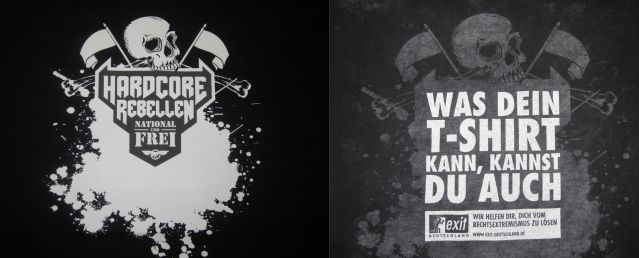What CVE Can Learn from Guerrilla Marketing
Editor’s Note: The Islamic State is weakened militarily, but many of the ideas it champions remain strong. In addition, the group continues to spread its message both virtually and in face-to-face settings. Katerina Papatheodorou of GWU's Program on Extremism argues that the United States and its allies can, and must, do better at blending online and offline efforts as part of their strategy to counter violent extremism.
***

Published by The Lawfare Institute
in Cooperation With

Editor’s Note: The Islamic State is weakened militarily, but many of the ideas it champions remain strong. In addition, the group continues to spread its message both virtually and in face-to-face settings. Katerina Papatheodorou of GWU's Program on Extremism argues that the United States and its allies can, and must, do better at blending online and offline efforts as part of their strategy to counter violent extremism.
***
Speaking to VICE News about the “Unite the Right” rally in Charlottesville, neo-Nazi Robert “Azzmador” Ray declared: "We are stepping off the internet in a big way… People realized they are not atomized individuals, they are part of a larger whole… We have been organizing on the internet, and so now they are coming out, and as you've seen today, we greatly outnumbered the anti-White, anti-American filth." His statement punctuated the importance of linking online efforts to real-world action, a sentiment alt-right leader Richard Spencer has expressed before. As he told VICE, “we memed alt-right into existence.”
In the wake of attacks, whether jihadist or far-right, it is commonplace for the debate to focus on the perpetrator’s online activities. Recently, reports suggested that James Alex Fields, Jr., the man who rammed his car into a crowd of protesters in Charlottesville, was a member of Vanguard America, a white supremacist group that actively recruits youth and propagates its message online. Virtual interactions and involvement in online social networks often have an effect on the radicalization process by complementing offline dynamics that are still imperative to mobilization. As a response, efforts to counter propaganda and promote alternative messages should include both on- and offline components. In this respect, preventing and countering violent extremism (P/CVE) efforts could learn from modern guerrilla marketing techniques.
Lately, the debate has focused on the role of technology companies in the fight against extremism, particularly whether social media companies should be held accountable for failing to stop the spread of extremist material online. Tech giants have launched a series of campaigns promoting the dissemination of counternarratives, and have tried to curb the presence of radical elements on their platforms. Facebook, for example, recently launched an initiative using artificial intelligence to identify extremist content, and the company supports the creation of counter-messages through their Peer2Peer program. Google's Jigsaw has launched The Redirect Method, which redirects extremist video searches on YouTube towards counter-messaging videos. One such video, for example, filmed inside Islamic State-held territory in Syria, shows an old Muslim woman confronting a group of terrorists, urging them to stop murdering innocent people while adeptly referencing Quranic verses to support her argument against the group's atrocities.
Content-based regulation, such as blocking websites or removing extremist propaganda, can only go so far. P/CVE must also include counter-messaging campaigns that help frame the narrative and reach the right audience. Such efforts are comparable to advertising and strategic communications initiatives employed by major private companies to raise awareness for and promote their products. Consequently, lessons can be drawn from marketing and related disciplines to help inform counter-messaging efforts.
Perhaps the trickiest component is how to link online and offline work.
For a marketing campaign to be effective, online efforts must be connected to offline activities. Online ventures can raise awareness and promote offline participation, while real-world actions increase interaction and encourage people to become involved. Perhaps the trickiest component is how to link online and offline work.
Coca-Cola's "Share a Coke" campaign may serve as a useful framework to highlight this approach. In an effort to reach young adults, the campaign incorporated social media and employed the hashtag #ShareACoke across various platforms, including Twitter, Facebook, and Instagram. The company also promoted the message through more traditional means, like roving kiosks and interactive advertisements. For example, the company encouraged people to text the name of an individual they wished to share a Coke with; the names were then displayed on Sydney’s iconic billboard at King’s Cross. The idea resulted in 110,000 submissions and was seen by 820 million people. When the initiative was launched in the United States, it was credited with a 2 percent increase in sales.
To be more effective, counter-narrative experts must pursue similar efforts that consistently employ counter-messages in both the virtual and non-virtual spheres. Indeed, there are examples of innovative counter-messaging campaigns that managed to link real-world efforts to the online environment successfully. Take, for instance, a campaign run by EXIT- Deutschland, an organization helping people leave radical far-right milieus. The Trojan T-Shirt project distributed 250 t-shirts containing a secret message at a neo-Nazi concert in Germany. The goal was to infiltrate the movement and raise awareness about EXIT and their services. The shirts may have looked like they were promoting another metal band, but when washed, they revealed a hidden statement: “if your shirt can do it, so can you – we can help you to get free of right-wing extremism. EXIT-Deutschland,” accompanied by a URL to EXIT’s website. Following the campaign, the number of individuals contacting EXIT seeking assistance to leave the far-right extremist movement tripled and donations increased by 334% compared to 2010.
In another campaign, during a scheduled neo-Nazi march in the small town of Wunsiedel, EXIT organized Rechts gegen Rechts (Nazis against Nazis) and turned the event into "the first involuntary charity walk." Residents and local businesses agreed to donate €10 for every meter the extremists covered. A social media campaign accompanied the event to raise awareness regarding Wunsiedel, while also allowing the public to follow the march in real-time. In the end, locals raised €10,000 for EXIT, and their plan became a social media hit. Though neo-Nazis still gather in Wunsiedel every year, locals believe that the campaign was relatively effective, with fewer people now descending on the town for the annual march. Furthermore, extremists now refrain from disseminating propaganda and trying to recruit locals. Other towns that followed Wunsiedel’s example have also reported a decrease in the number of Neo-Nazi’s participating in marches each year.
The two initiatives by EXIT-Deutschland represent an excellent example of the successful blending of online and offline measures. Counter-messaging campaigns are an important aspect of P/CVE, and online efforts can expand their reach. However, amidst the 24-hour news cycle and the countless messages we continuously receive, it is easy for information to get lost in the noise. To sustain attention, support, and subsequent involvement, it is essential for online efforts to be complemented by offline action.
In this context, it is critical to recognize the utility and effectiveness of simple marketing tools like newspaper and television ads, and guerrilla-marketing tactics like temporary graffiti and street games. Hashtags and URLs printed on billboards and incorporated into publications can also circulate the narrative and raise awareness. Furthermore, creative offline campaigns, like interactive exhibits, branded or short links printed on clothing, vehicle wraps, or eye-catching ads displaying imaginative and original designs, can generate interest and increase interactions both on- and offline. A strong narrative should be a memorable call to action, encouraging engagement and participation. Most importantly, it should include a consistent message that resonates with and reaches individuals across the right platforms.
While the aforementioned programs, and initiatives like the recently announced Tech Against Terrorism are a great first step to leverage the resources and expertise of social media and technology companies in the fight against extremism, researchers, civil society, and governments also need to intensify efforts to promote alternative messages. However, without a comprehensive strategic communications plan linking offline initiatives to online actions, efforts to counter extremist narratives will be less effective.





